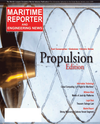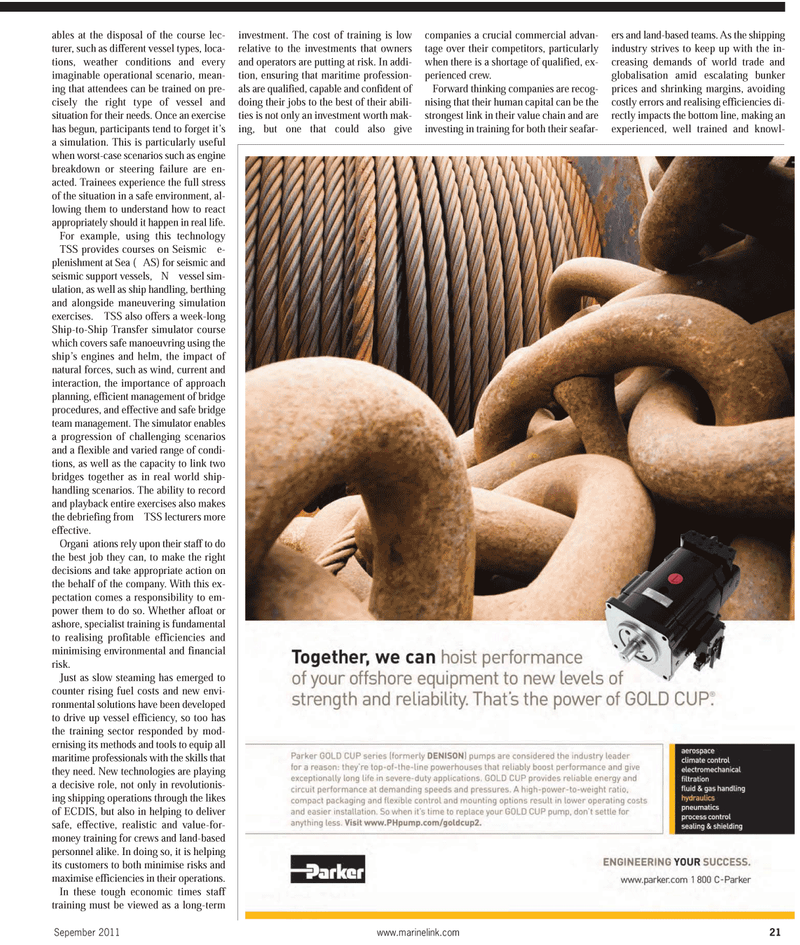
Page 21: of Maritime Reporter Magazine (September 2011)
Marine Propulsion Annual
Read this page in Pdf, Flash or Html5 edition of September 2011 Maritime Reporter Magazine
Sepember 2011www.marinelink.com 21ables at the disposal of the course lec-turer, such as different vessel types, loca- tions, weather conditions and every imaginable operational scenario, mean-ing that attendees can be trained on pre-cisely the right type of vessel and situation for their needs. Once an exercise has begun, participants tend to forget it?s a simulation. This is particularly useful when worst-case scenarios such as engine breakdown or steering failure are en- acted. Trainees experience the full stress of the situation in a safe environment, al- lowing them to understand how to react appropriately should it happen in real life.For example, using this technology TSS provides courses on Seismic e- plenishment at Sea (AS) for seismic and seismic support vessels, N vessel sim- ulation, as well as ship handling, berthingand alongside maneuvering simulation exercises. TSS also offers a week-long Ship-to-Ship Transfer simulator course which covers safe manoeuvring using the ship?s engines and helm, the impact of natural forces, such as wind, current andinteraction, the importance of approachplanning, efficient management of bridge procedures, and effective and safe bridge team management. The simulator enables a progression of challenging scenariosand a flexible and varied range of condi- tions, as well as the capacity to link two bridges together as in real world ship- handling scenarios. The ability to record and playback entire exercises also makes the debriefing from TSS lecturers more effective. Organiations rely upon their staff to do the best job they can, to make the right decisions and take appropriate action on the behalf of the company. With this ex- pectation comes a responsibility to em-power them to do so. Whether afloat or ashore, specialist training is fundamentalto realising profitable efficiencies and minimising environmental and financial risk.Just as slow steaming has emerged to counter rising fuel costs and new envi- ronmental solutions have been developed to drive up vessel efficiency, so too has the training sector responded by mod-ernising its methods and tools to equip allmaritime professionals with the skills thatthey need. New technologies are playing a decisive role, not only in revolutionis- ing shipping operations through the likes of ECDIS, but also in helping to deliver safe, effective, realistic and value-for- money training for crews and land-based personnel alike. In doing so, it is helping its customers to both minimise risks andmaximise efficiencies in their operations. In these tough economic times staff training must be viewed as a long-term investment. The cost of training is low relative to the investments that owners and operators are putting at risk. In addi-tion, ensuring that maritime profession-als are qualified, capable and confident of doing their jobs to the best of their abili-ties is not only an investment worth mak- ing, but one that could also give companies a crucial commercial advan- tage over their competitors, particularly when there is a shortage of qualified, ex- perienced crew. Forward thinking companies are recog- nising that their human capital can be thestrongest link in their value chain and are investing in training for both their seafar- ers and land-based teams. As the shipping industry strives to keep up with the in- creasing demands of world trade and globalisation amid escalating bunker prices and shrinking margins, avoiding costly errors and realising efficiencies di- rectly impacts the bottom line, making anexperienced, well trained and knowl-

 20
20

 22
22
